The best hybrids (varieties) of self-pollinated (parthenocarpic) cucumbers for growing in a greenhouse and open field
There are more and more varieties, and especially hybrids of cucumbers, every year. At the same time, exclusive attention and preference is given to the most early ripening, productive, long-bearing and resistant to various diseases.
Of course, self-pollinating cucumbers are now the most popular, or rather parthenocarpic hybrids, which are usually grown in greenhouses.
Next, let's talk in more detail about what self-pollinated cucumbers are, or rather parthenocarpic hybrids, what are their advantages and nuances of growing. In addition, your attention will be provided with a list of the most popular and best self-pollinated cucumber varieties that are intended for growing in a greenhouse (primarily) and open field.
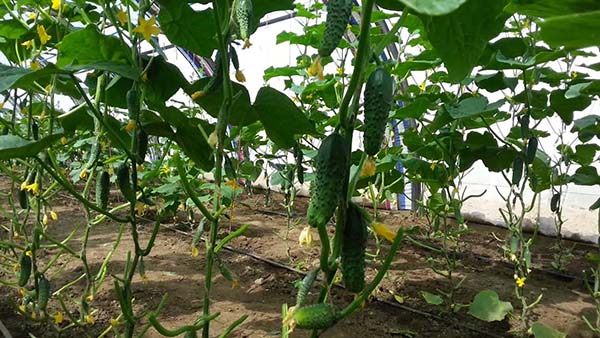
Content
What are self-pollinated cucumbers, what are their advantages and features of cultivation
By the way! It is not entirely correct (more precisely, in principle, incorrect) to call parthenocarpic cucumbers self-pollinated. Indeed, in order to be self-pollinated, flowers must have both a pistil and stamens (for example, like peppers or tomatoes). The cucumber does not have bisexual flowers: they are all either female or male (barren flowers)... In other words, in the literal sense, self-pollinated cucumbers do not exist.
It is more correct to call them "Not requiring pollination".
But you say what is written in this way on the packaging itself. Indeed, they write this way for amateurs, trying to convey information to the consumer as easily as possible.
Parthenocarpic cucumbers have only female flowers and are able to develop into fruits without any insect pollination, while growing without seeds inside the greenery.
Benefits growing parthenocarpic cucumbers:
- Ideal for growing indoor - greenhouse, on the balcony and at home on the windowsill, where it is very difficult for pollinating insects (bees, bumblebees) to get.
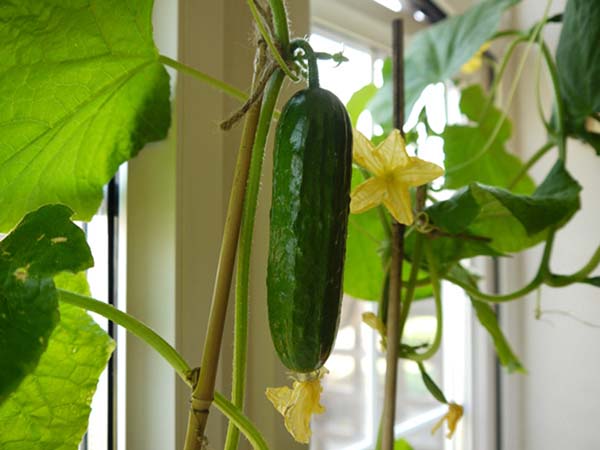
Note! Most parthenocarpic varieties are also suitable for outdoor cultivation.
- As a rule, they have fruits of the same size and color, genetically without bitterness, and they also do not turn yellow (since the seeds do not ripen in them).
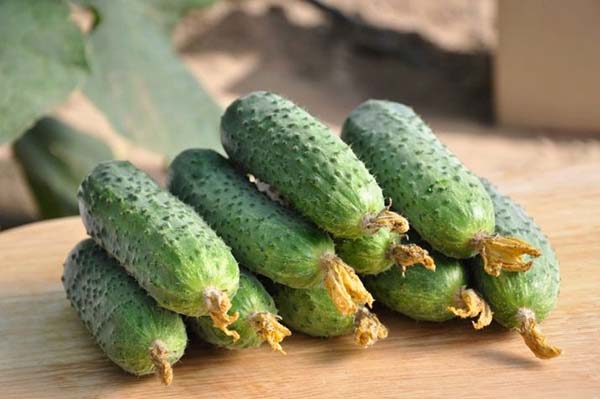
However, these are rather the benefits of hybrid cucumber.
Features: growing parthenocarpic cucumber hybrids:
- Since parthenocarpic hybrids only female flowers, which means that there is a very high load on the bush, then such plantsshaping required - rationing of the number of fruits, blinding of the lower nodes, etc.
By the way! More details about shaping (pinching, pinching) cucumbers read in this article.
- Shake female flowersso that they "self-pollinate", useless and pointless.
Interesting! The meaning of self-pollination is that pollen from its own flower spills out onto its own pistil and germinates, forming an ovary with seeds.
- Parthenocarpic and bee-pollinated cucumbers cannot be grown in the same greenhouse (garden)otherwise, with such a joint planting, the greens will turn out to be crooked, ugly and, as a rule, pear-shaped (bottle-shaped). The thing is that pollinating insects (bees, bumblebees) will also pollinate the flowers of parthenocarpic cucumbers, which do not need it and will only harm them.
Alternative opinion: “The neighborhood of bee-pollinated cucumbers will not harm, but, on the contrary, will help the setting of parthenocarpic varieties.
Their female flowers can tie greens even without pollination, but absolutely normal fruits grow from the pollinated ones.
And when the parthenocarpic ones "are capricious", shedding ovaries, pollination definitely helps. "
Video: parthenocarpic cucumbers, hybrids and GMOs
Self-pollinated cucumbers for greenhouses and open ground: the best hybrids (varieties)
A review list of the best self-pollinated (parthenocarpic) cucumbers was prepared based on the degree of popularity of the names of hybrids, on the reviews of experienced gardeners, as well as the personal opinion of the author.
The most popular and best self-pollinated cucumber hybrids (varieties) (alphabetically):
Note! Naturally self-pollinated (parthenocarpic) cucumbers are primarily intended for cultivation in a greenhouse (indoor). However, this is by no means does not mean that they cannot be grown in the open field (all the more so at first under temporary shelters). Sure you may. One has only to take into account that the yield will not be so high (as a rule, the yield when grown in greenhouses is indicated in the characteristics of the variety).
Important! The descriptions give recommendations on the place (method) of growing a particular hybrid (variety).
Self-pollinated (parthenocarpic) hybrids: top 35
Adam F1
- Early maturing parthenocarpic hybrid, 45-52 days from germination to fruiting.
- The plant is indeterminate, medium-sized.
- Recommended for open ground, temporary film shelters and film greenhouses.
- Fruits are green, cylindrical, small tuberous with light white pubescence.
- Length - 9-10 cm, diameter - 3.0-3.7 cm, weight - 90-95 g.
- Productivity - up to 8.2-10.2 kg per sq. meter.
- Good taste.
- Multipurpose: perfect for making fresh summer salads and canning.
- Resistant to olive spot (cladosporiosis), powdery mildew and cucumber mosaic virus.
Alex F1
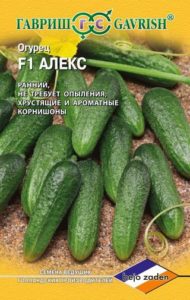
- Early parthenocarpic hybrid (from sowing to fruiting 45-50 days).
- The plant is indeterminate, medium-sized, medium-growing, in each node 1-3 ovaries are formed.
- For growing in the open field and under temporary cover films.
- The fruit is short, dark green, with very short stripes, small tuberous, white thorny.
- Weight - 70-90 g.
- Productivity - up to 2.8-5.7 kg per square meter.
- The taste is excellent.
- Universal purpose: zelents are perfect for making salads, canning and pickling.
- Resistant to cucumber mosaic virus, powdery mildew and olive spot.
Cupid 1801 F1
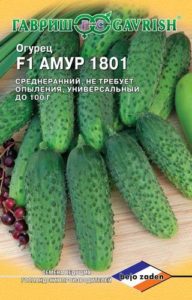
- Mid-early parthenocarpic hybrid (45-55 days from mass germination to the beginning of technical ripeness).
- The plant is indeterminate, medium-sized, medium-branched.
- For growing in open ground, in plastic greenhouses and under temporary plastic shelters.
- The fruit is cylindrical, dark green, with short light stripes, small tuberous, white pubescence.
- Weight - 95-100 g, length - up to 9.5 cm, diameter - up to 3.2 cm.
- Marketable yield - 8.5-11.2 kg per square meter.
- Excellent taste.
- Universal use: for salads and canning.
- Resistant to olive spot, cucumber mosaic virus, powdery mildew.
April F1
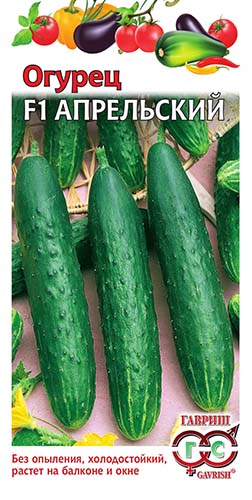
- An early ripe hybrid, fruiting occurs 45-50 days after germination.
- Partially parthenocarpic, for better fruiting, pollination is advisable in the first month of fruiting.
- The limited lateral branching excludes the periodic work on pinching and pinching.
- For indoor cultivation (greenhouse).
- Can be grown on the balcony and indoors.
- The fruit is green, cylindrical, slightly lumpy.
- Length - 15-25 cm, weight - 200-250 grams.
- Productivity - up to 24 kg per sq. meters (in the first month of fruiting - 7-13 kg per square meter).
- Good taste.
- Universal use (for salads and canning).
- Cold resistant.
- Has long-term fruiting.
- Possesses complex resistance to major diseases.
Artist F1
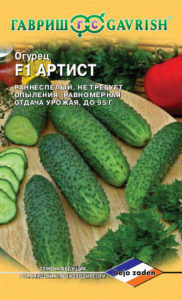
- Early maturing parthenocarpic hydride (38-50 days from mass emergence to the beginning of technical ripeness).
- The plant is indeterminate, vigorous, medium-branched, with a strong root system.
- For growing in the open field and under temporary cover films.
- The fruit is short, cylindrical, dark green, with short stripes and weak spotting, medium tuberous, white pubescence.
- Weight - 90-95 g.
- Productivity - up to 8.5 kg per square meter.
- Has good taste.
- Versatile: Recommended for salads and pickles.
- Resistant to cladosporiosis, cucumber mosaic virus, moderately resistant to powdery mildew and downy mildew.
Herman F1
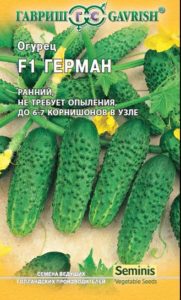
- Early maturing parthenocarpic hybrid, fruiting in 40-45 days from germination.
- The plant is determinate, medium-sized. With bunched ovaries. With sufficient nutrition, it forms 6-7 fruits on each node.
- It is intended for growing in open ground, under temporary film shelters, as well as in protected ground (film greenhouses).
- Fruits are dark green, flattened, cylindrical, tuberous, with white pubescence.
- Length - 10-12 cm, diameter - 2.9-3.1 cm, weight - 70-90 g.
- Productivity - up to 8.5-9 kg per square meter.
- Taste good or great. There is no bitterness.
- Universal use: perfect for pickling, pickling and fresh consumption.
- Resistant to cucumber mosaic virus, cladosporium and powdery mildew.
Garland F1
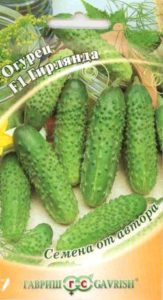
- Early maturing parthenocarpic hybrid, fruiting 45-50 days after germination.
- Plant with vigorous growth, slightly branched. Form into one stem. With bouquet (bundle) setting of ovaries (up to 4-5 in one node).
- For growing in a film greenhouse.
- Shade-tolerant, so it can be grown on a balcony, loggia or indoors.
- Fruits are dark green, often lumpy, whitish,
- Length - 12-14 cm, weight - 120-130 grams.
- Productivity - up to 14-16 kg per sq. meters.
- Excellent taste and aroma. Fruits do not turn yellow, retain their presentation for a long time.
- Universal use: perfect for pickling, pickling and fresh consumption.
- Relatively cold-resistant.
- Resistant to root rot, powdery mildew, olive spot, relatively resistant to downy mildew.
Gunnar F1
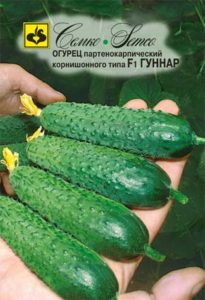
- Early ripe parthenocarpic hybrid (from germination to the beginning of fruiting 38-40 days.).
- For growing in plastic greenhouses and open field.
- The plant is indeterminate, compact, with short lateral shoots, bouquet (bunch) type of flowering (up to 4 ovaries in one node).
- The fruit is dark green, short, fusiform, large tuberous.
- Length - 8-12 cm.
- Excellent taste. No bitterness.
- Productivity - up to 20.8 kg per sq. meter.
- Universal use: salad, canning.
- Resistant to powdery mildew, cladosporium disease, cucumber mosaic virus.
F1 Director
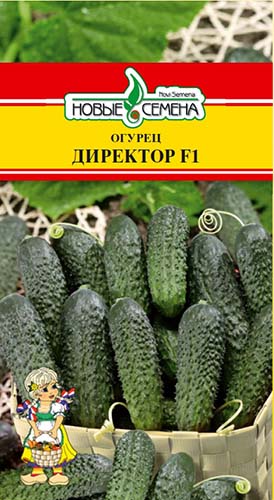
- Mid-season parthenocarpic hybrid, fruiting occurs 43-45 days after germination.
- The plant is indeterminate, medium-sized, strongly branched.
- The number of female flowers in a node is 2-3 pcs.
- For open ground and temporary film shelters, as well as film greenhouses.
- The fruit is dark green, elongated-cylindrical, with short stripes, tuberous, pubescence is white, of medium density.
- Length - 9-10.5 cm, diameter - 3-3.5 cm, weight 65-80 g.
- Productivity - up to 12-20 kg per sq. meters.
- The taste is good and excellent. No bitterness.
- For salad purposes, but can also be preserved.
- Resistant to cucumber mosaic virus, powdery mildew, cucumber vessel yellowing virus, tolerant to downy mildew. Stress tolerant.
Director F1
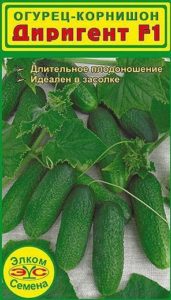
- Mid-early parthenocarpic hybrid.
- The plant is indeterminate, medium-sized, medium-branched, the number of female flowers at a node is 1-3.
- For growing in open ground and film greenhouses.
- The fruit is short, cylindrical, dark green with short stripes and with moderately pronounced spotting, small tuberous, white, dense pubescence.
- Weight - 67-80 g.
- The taste is good and excellent.
- Universal: salad, canning.
- Resistant to cladosporium and cucumber mosaic virus.
Emelya F1
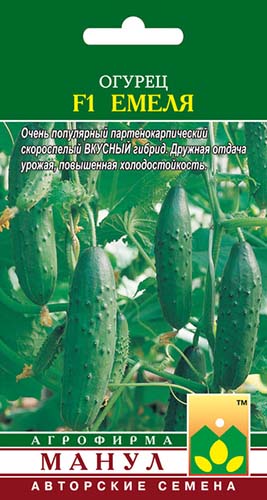
- An early ripening parthenocarpic hybrid, begins to bear fruit on days 39-43 after full germination.
- Female or predominantly female flowering type
- The plant is indeterminate, vigorous, medium-branched, with bundled ovaries.
- For spring greenhouses, tunnels, open ground.
- Fruits of intense green color, large lumpy white thorns, oval-cylindrical shape,
- Weight - 120-150 g, length - 13-15 cm, diameter - 4.0-4.4 cm.
- Very high taste, excellent for pickling and preserving.
- Productivity - 12-16 kg per square meter.
- Increased cold resistance. Resistant to olive spot, cucumber mosaic virus, root rot and powdery mildew tolerant.
Zozulya F1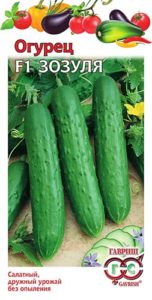
- An early ripe hybrid, fruiting 45-50 days after germination (according to other sources, 40-45 days).
- Partially parthenocarpic. It has mainly female flowers, but bears fruit better at the initial bee pollination.
- The plant is medium-growing, branching is weak.
- For indoor cultivation (film greenhouse).
- Can be grown on the balcony.
- Fruits are cylindrical, slightly lumpy, whitish.
- Length - 14-24 cm, weight - 150-300 grams.
- High yield - up to 40 kg per sq. meter (according to other sources up to 15-25 kg).
- Great taste. The fruits do not taste bitter, do not turn yellow and retain their presentation for a long time.
- Mainly for salad purposes, but young greens can also go for salting.
- Relatively cold-resistant.
- Differs in amicable and long-term fruiting.
- Resistant to olive spot and cucumber mosaic virus.
Zyatek F1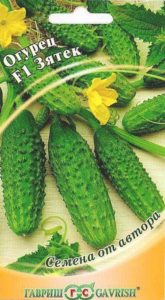
- Early ripening parthenocarpic hybrid (45-48 days from germination to fruiting)
- The plant is indeterminate, medium-branched, has a strong root system, intensive growth. Bouquet type of flowering (bundle ovary formation). In the axil of leaves 2-4 ovaries are formed (up to a maximum of 6-8 ovaries).
- Designed for growing in open ground and film greenhouses.
- The fruit is dark green with light stripes, cylindrical, tuberous, white-thorn.
- Length - 10-12 cm, diameter - 3.0-3.5 cm, weight - 90-100 g.
- Productivity - up to 5.0-7.0 kg per 1 plant or 13.2 kg per square meter.
- The taste is excellent. No bitterness.
- The use of fruits is universal (fresh, salting, pickling).
Can be harvested for pickles and gherkins.
- Resistant to root rot, powdery mildew, resistant to downy mildew.
Emerald F1 earrings
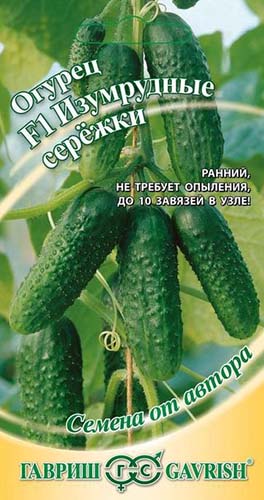
- Early ripening parthenocarpic hybrid (42-47 days from germination to fruiting).
- The plant is indeterminate, vigorous, medium-branched. With a bouquet (bundle) arrangement of ovaries (up to 8-10 per knot).
- For cultivation in greenhouses, under temporary cover films and in the open field.
- Fruits are cylindrical, dark green, with frequent medium-sized tubercles, white thorns.
- Length - 9-11 cm, diameter -3.0-4.0 cm, weight - 100-110 g,
- Productivity - 11-12 kg per square meter.
- Universal use: salad, canning.
Ideal for picking pickles and gherkins.
- Resistant to powdery mildew, olive spot, relatively resistant to downy mildew, root rot and bacteriosis.
Emerald Stream F1
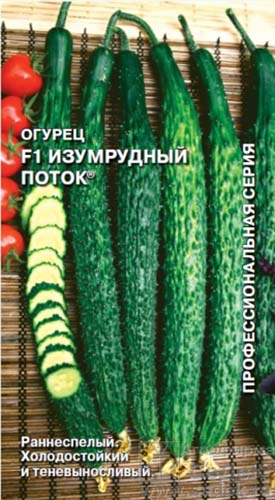
- An early ripening parthenocarpic hybrid, bears fruit 44-48 days after germination.
- The plant is vigorous, weakly braided, advantageous with a female flowering type.
- For open ground and film shelters.
- The fruit is long, elongated-cylindrical, dark green, slightly ribbed, tuberous, pubescence is white, of medium density.
- Weight - 150-200 g, length - 30-50 cm.
- The taste is excellent, aromatic.
- Salad destination.
- Outdoor yield - up to 6.0 kg per square meter.
- Cold resistant. Shade tolerant.
- Resistant to powdery mildew.
Claudia F1
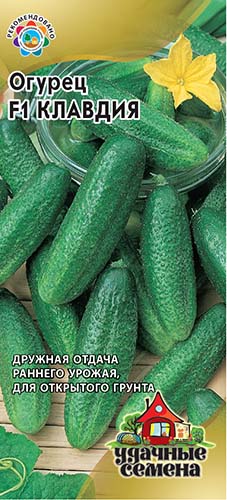
- Early maturing parthenocarpic hybrid.
- The plant is climbing, with a bouquet (bundle) setting of ovaries (more than 3 in a node).
- For growing outdoors under temporary cover films.
- The fruit is cylindrical, small tuberous, green to dark green, with short stripes, white pubescence.
- Length - 10-12 cm, diameter - 3-4 cm, weight - 64-89 g.
- Productivity - up to 2.1-4.8 kg per sq. meter.
- Recommended for pickling and pickling, suitable for fresh consumption.
- It has a complex resistance to the main diseases of cucumbers.
Connie F1
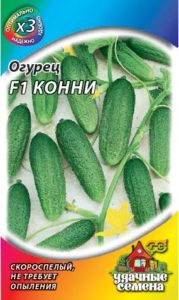
- Early ripening parthenocarpic hybrid (from germination to fruiting 47-50 days).
- The plant is indeterminate, vigorous, medium-growing, medium-leafy, with a tendency to bunched ovaries.
- For growing in film greenhouses.
- The fruit is cylindrical, very short, green, small and tuberous, with white pubescence.
- Length - 7-9 cm, weight - 60-82 g.
- Productivity - up to 12.6-16.0 kg per sq. meter (at the beginning of fruiting to early - 8.7-9.2 kg).
- The fruits are delicious and aromatic.
- Universal use: salad, canning.
- Resistant to powdery mildew and root rot.
Grasshopper F1
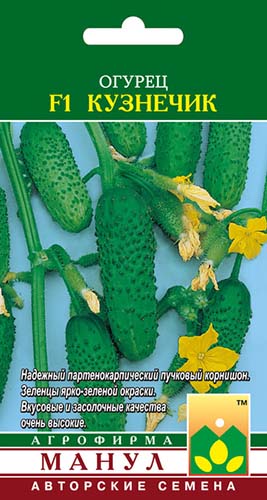
- An early ripening paternocarpic hybrid, begins to bear fruit on 39-42 days from germination.
- The plant is indeterminate, vigorous, branching is limited. The bundle of ovaries is formed in the nodes from 2-3 to 4-6 ovaries.
- Designed for growing in open and protected ground.
- Fruits are large tuberous, white-spiked, bright green in color, pubescence is frequent.
- Weight - 90-110 g, length - 10-12 cm, diameter - 3.2-3.5 cm.
- Productivity - up to 10-14 kg per sq. meter.
- Salting and canning qualities are very high.
- Resistant to powdery mildew, olive spot, cucumber mosaic virus, tolerant to downy mildew.
Courage F1
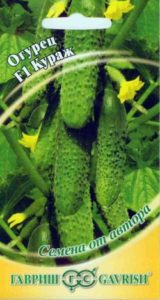
- Early ripening parthenocarpic hydride, from germination to fruiting 45-50 days.
- Designed for growing in film greenhouses.
- Plants are indeterminate, vigorous, shoot-forming ability is average. With bundle ovaries, 2-4 ovaries are formed at the nodes (up to 5-6 ovaries).
- The fruit is dark green, with light stripes, lumpy, whitish.
- Length - 12-15 cm, diameter - 4.0-4.5 cm, weight - 120-130 g.
- Productivity - 6-8 kg per plant or up to 16-18 kg per square meter.
- Taste good and excellent, without bitterness.
- Universal use (for salad and canning).
- Relatively resistant to major diseases.
Boy with thumb F1
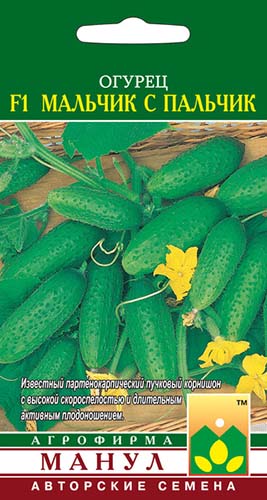
- A very early ripening parthenocarpic hybrid, begins bearing fruit on the 37-39th day from germination.
- The plant is indeterminate, vigorous, medium-growing. The bundle of ovaries is formed in the nodes from 2-3 to 5-6 ovaries.
- For open ground, spring greenhouses and tunnels.
- The fruits are lumpy, white-thorny, bright green, with frequent pubescence, but the thorns are not thorny.
- Length - 6-10 cm, weight - 50-65 g.
- Productivity - 10-13 kg per square meter.
- Universal use: salad, pickling. The taste is high.
- The hybrid is resistant to powdery mildew, olive spot, cucumber mosaic virus, tolerant to downy mildew.
Marinda F1
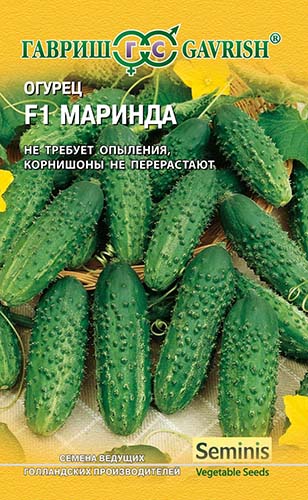
- Early maturing parthenocarpic hybrid.
- The plant is medium-sized. With sufficient nutrition, up to 6-7 ovaries are formed in each node (prone to bundle arrangement of ovaries).
- For cultivation in greenhouses and open field.
- Fruits are dark green, lumpy, with white thorns,
- Length - 8-10 cm.
- The fruits are delicious and crispy.
- Universal use: for fresh consumption, pickling and pickling.
- Resistant to major cucumber diseases and unfavorable growing conditions.
Maryina Roshcha F1
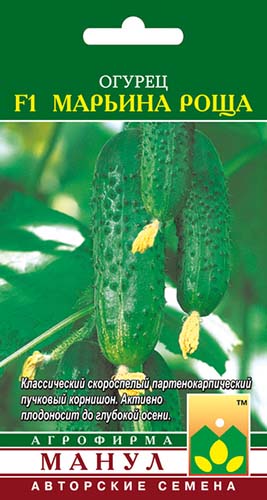
- Early maturing parthenocarpic hybrid. It starts bearing fruit on the 39-42nd day after full germination.
- The plant is indeterminate, vigorous, with good regrowth of lateral shoots. With bundled ovaries, from 2-3 to 4-5 ovaries are formed at the nodes.
- For open and protected ground.
- Fruits are intensely green in color, lumpy, white-thorny, dense, tubercles are large, the location of tubercles is medium-frequent.
- Weight - 100-110 g,length - 10-12 cm, diameter - 3.0-3.4 cm.
- Productivity - 10-13 kg per square meter.
- Salting and taste qualities are high. Very aromatic and crispy.
- Cold-resistant and shade-tolerant. Resistant to powdery mildew, olive spot, cucumber mosaic virus, tolerant to downy mildew, root rot.
Fruiting until late autumn.
Masha F1
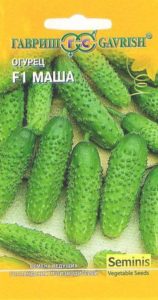
- Early maturing parthenocarpic hybrid, fruiting occurs 37-39 days after germination.
- The plant is determinate, medium-sized, with limited shoot-forming ability. With bunched ovaries. With sufficient nutrition, the plant forms up to 6-7 fruits in each node.
- Suitable for growing in the open field and under a film cover.
- Fruits are cylindrical, leveled, dark green, lumpy, whitish.
- Length - 8-9 cm, diameter - 3.0-3.5 cm.
- Productivity - up to 10-11 kg per sq. meters.
- Excellent taste. Without emptiness and bitterness.
- Universal use: for fresh consumption and canning.
- Resistant to cucumber mosaic virus, downy mildew and downy mildew, cladosporiosis.
Meringue F1
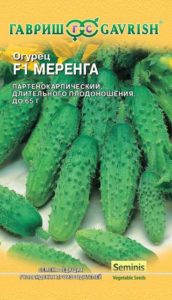
- Early ripe parthenocarpic hybrid (37-40 days from germination to fruiting).
- The plant is indeterminate, medium-growing. In one node simultaneously forms up to 4-5 fruits.
- Recommended for growing in greenhouses, film shelters, in the open field.
- The fruit is dark green, cylindrical, large tuberous, with white pubescence. Resistant to yellowing and deformation.
- Length - 8-10 cm, weight - up to 65 grams.
- Productivity - up to 15.2 kg per square meter.
- The taste is excellent. No bitterness.
- Universal: intended for fresh consumption and processing.
- Resistant to cladosporiosis, cucumber mosaic virus, downy mildew and powdery mildew.
Ant F1
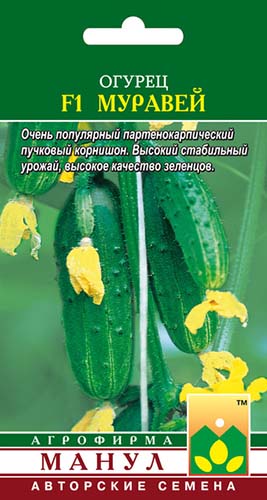
- Early ripening parthenocarpic hydride (begins to bear fruit 37-38 days after germination).
- The plant is indeterminate, the vigor of growth is medium, weakly branched, bundle formation of ovaries (from 2-3 to 5-7 ovaries are formed at the nodes).
- For growing under cover films.
- The fruit is oval, green with stripes of medium length, slightly ribbed, tubercles are large, medium density, pubescence is white
- Weight - 100-110 g, length 8-11 cm, diameter 3.0-3.4 cm.
- Productivity - up to 10-12 kg per square meter.
- Salting, taste and canning qualities are very high.
- Universal use: salad, canning.
- The hybrid is resistant to powdery mildew, olive spot (cladosporium), the common cucumber mosaic virus, and is tolerant to downy mildew.
Active formation of zelents due to a strong parthenocarp is observed from the lowest nodes of the stem in almost any weather conditions.
Goosebump F1
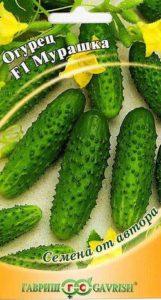
- Early ripening parthenocarpic hybrid (43-48 days from germination to fruiting).
- The plant is indeterminate, vigorous, medium branching. Bouquet type of flowering (bundle ovary laying). 4-6 ovaries are formed in each axil of the leaf.
- It can be grown both in protected ground (film greenhouses) and in open ground under temporary film shelters.
- Fruits are dark green, short, cylindrical, with large wide tubercles, black thorns.
- Length - 11-13 cm, diameter 3.5-4 cm, weight - 90-110 g.
- Productivity - 6-7 kg per 1 plant or up to 10.3-12.0 kg per sq. meter.
- The taste is excellent.
- Universal use: for pickling, pickling, salads.
Great for cask pickling.
- Resistant to powdery mildew, relatively resistant to downy mildew and root rot.
Real Colonel F1
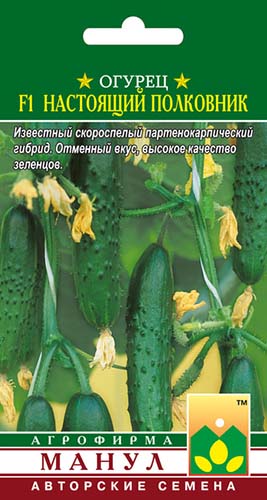
- An early ripe parthenocarpic hybrid, begins to bear fruit 40-42 days after full germination.
- The plant is indeterminate, vigorous, medium branching, predominantly female flowering type, the number of female flowers in a node is 1-3.
- For growing outdoors under a film cover or film greenhouses.
- The fruit is fusiform with a short neck, slightly ribbed, green with stripes of medium length, medium-sized tubercles, sparse, white pubescence.
- Weight - 120 g, length - 12-15 cm, diameter - 3.8-4.4 cm.
- Productivity - up to 10-13 kg per sq. meter.
- The taste is excellent.
- Universal use: for salad and pickling.
- It is resistant to cucumber mosaic virus, cladosporium disease, powdery mildew and root rot tolerant.
Paratunka F1
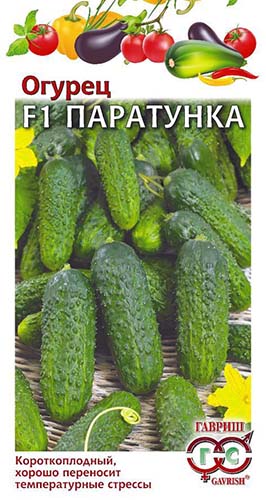
- Early ripening parthenocarpic hybrid, fruiting 40-43 days after germination.
- For cultivation in open and closed ground.
- The plant is indeterminate, medium-sized, medium-branched. The number of female flowers in a node is 3 or more.
- Fruits are dark green, cylindrical, medium lumpy, slightly ribbed, whitish.
- Length - 8-10 cm, diameter - 2-3 cm, weight - 75-100 g.
- Productivity - up to 12-16 kg per sq. meters.
- The taste is excellent. The pulp is crispy, aromatic, sweet, without bitterness.
- Universal use: for fresh consumption, pickling or pickling.
- Resistant to powdery mildew, cladosporiosis.
- It tolerates temperature stress well.
F1 partner
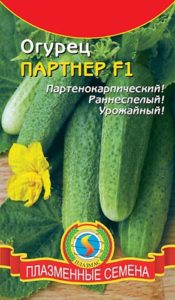
- Early maturing parthenocarpic hybrid (45 days after germination to the beginning of fruiting).
- The plant is indeterminate, medium-sized, medium-branched.
- For growing in the open field, but also indoors.
- The fruit is short, cylindrical, dark green, tuberous, pubescence is white, dense.
- Length - 6-8 cm, weight - 58-76 g.
- Productivity - up to 1.7-3.5 kg per sq. meters.
- The taste is good. No bitterness.
- Universal use: salad, canning.
Prestige F1
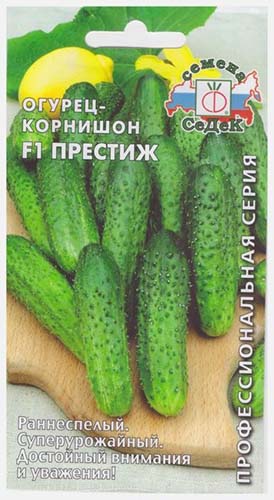
- Early maturing parthenocarpic hybrid (42-45 days).
- The plant is indeterminate, medium-sized, medium-growing, with a bundle arrangement of ovaries (up to 3-4 in one node).
- For growing in the open field and under film shelters.
- The fruit is short, cylindrical, large tuberous, dark green with short stripes, with white pubescence.
- Length - 8-10 cm, weight - 65-90 grams.
- Productivity - up to 25 kg per sq. meters.
- The taste is good and excellent.
- Mostly canned food, but will also work for salads.
- Resistant to disease and stress: temperature extremes and darkening.
Pace F1
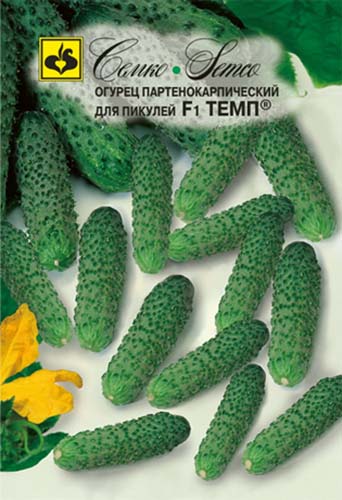
- An early ripening parthenocarpic hybrid, begins to bear fruit on 42-44 days after full germination (pickles in 37-38 days).
- The plant is indeterminate, weakly branched, characterized by bundle fruiting, the number of female flowers in a node is 3 or more (4-5).
- For growing under cover films.
- The fruit is very short with a short neck, cylindrical, dark green with stripes of medium length, tuberous, pubescence is white, of medium density.
- Length - 5-9 cm, diameter - 1.6-2 cm, weight - 70-80 g.
- Productivity - up to 11-15 kg per square meter (average - 14.3 kg per square meter), when picking pickles - up to 5-7 kg.
- The taste is excellent. No bitterness.
- Universal use: salad, canning, pickling.
Ideal for picking pickles.
- Resistant to cladosporiosis, powdery mildew, tolerant to downy mildew and cucumber mosaic virus.
Mother-in-law F1
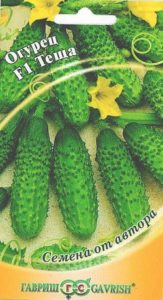
- Early ripening parthenocarpic hybrid (45-48 days from germination to fruiting).
- The plant is indeterminate, medium-branched. Bouquet type of flowering (bundle ovary formation). Up to 3-4 ovaries are formed in the leaf axil.
- Designed for growing in open ground and film greenhouses.
- The fruit is dark green, cylindrical, lumpy, brownish.
- Length - 11-13 cm, weight - 100-120 g,
- The yield of one plant is up to 5.5-6.5 kg or up to 12.2 kg per square meter.
- The use of fruits is universal: fresh, salting, pickling.
- Fine, delicate taste. No bitterness.
- Cold resistant.
- Possesses complex resistance to the main diseases of cucumber (resistant to powdery mildew, tolerant to downy mildew).
Furor F1
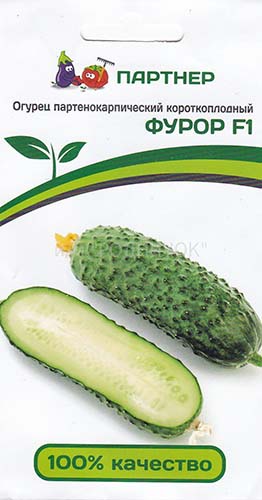
- Very early parthenocarpic hybrid, from germination to fruiting 37-39 days.
- Plants with a strong root system and short side shoots. Bouquet (bunch) type of flowering (2-4 fruits are tied in a knot).
- Recommended for greenhouse cultivation, but also suitable for planting in open ground.
- Fruits are dark green, without stripes, well pinned.
- Length - 10-12 cm, diameter - 3 cm, weight - 63 grams.
- Productivity - more than 20 kg per square meter.
- High taste.
- Ideal for pickling.
- Resistant to olive spot (cladosporiosis), powdery mildew and cucumber mosaic virus.
Shosha F1
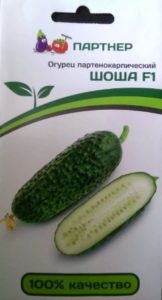
- Early maturing parthenocarpic hybrid, fruiting occurs 39-43 days after germination.
- The plant is indeterminate, medium-branched. The bundle arrangement of the ovaries, up to 3 ovaries are formed in the knot.
- For growing in the open field and under temporary film shelters, as well as in closed ground (greenhouses).
- The fruit is green, cylindrical, medium lumpy, with thorns and pubescence.
- Length - 9-11 cm, diameter - 3-3.5 cm, weight - 50-80 g.
- Productivity - up to 14.5 kg per sq. meters.
- The taste is good.
- Mostly for salad purposes, but also suitable for canning.
- Resistant to major diseases: common cucumber mosaic, powdery mildew, target leaf spot and cucumber vein yellowing virus.
Ecole F1
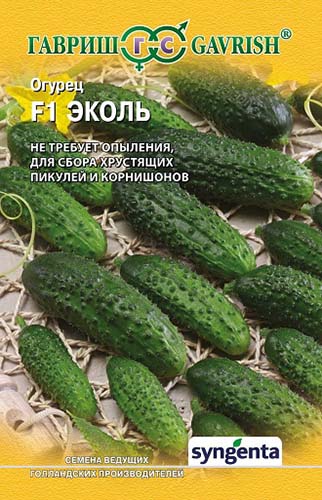
- Mid-early parthenocarpic hybrid, 43-45 days from germination to fruiting).
- The plant is indeterminate, medium-sized, medium-growing, with short internodes.
- Recommended for growing in greenhouses, film shelters and in the open field.
- The fruit is deep green, short, cylindrical, medium or large tuberous, pubescence is white, dense.
- Weight - 62-72 g.
- Productivity - 2.6-2.93 kg per sq. meters.
- The taste is excellent, without bitterness.
- Universal type: salad and canning (pickles, gherkins).
Ideal for picking pickles (fruits 4-5 cm long).
- Resistant to cladosporium and powdery mildew, relatively resistant to cucumber mosaic virus.
Other popular parthenocarpic hybrids (varieties)
Of course, in addition to those described in detail above, there are many other good parthenocarpic varieties (hybrids) of cucumbers. For example (the most popular are highlighted):
- Anyuta;
- Arina;
- Petrel;
- Cheetah;
- Gerasim;
- Egoza;
- Emerald placer;
- Kotor;
- Makar;
- Martha;
- Mill;
- Mu Mu;
- Moscow Nights;
- Regina;
- Rhythm;
- Company's secret;
- Dragonfly;
- The hit of the season;
- Clean ponds;
- And many others.
By the way! There are no parthenocarpic varieties, only hybrids.
So, all you have to do now is choose the parthenocarpic hybrid that suits you best. Indeed, now the market presents a great variety of the most diverse varieties, which means that some (or even several) will definitely be able to satisfy your taste and quantitative desires. Experiment, plant, try and find your personal best parthenocarpic (self-pollinated) hybrid (or several).
Important! It is not enough just to choose a good variety, you must follow the cultivation technique. Namely correctly shape (pinch), tie up, to water and feed cucumbers.
Video: early ripening parthenocarpic cucumbers for the greenhouse (a review of varieties from the Semko company)


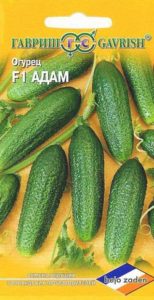
The neighborhood of bee-pollinated cucumbers WILL NOT HARM, but, on the contrary, will help the setting of patrenocarpic varieties.
Izh female flowers can tie zeoens without pollination, but POLLINATED are absolutely normal fruits.
And when the parthenocarpic is capricious, shedding the ovaries, pollination UNWAYS HELPS !!!